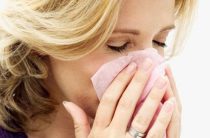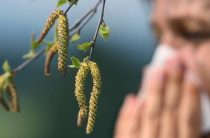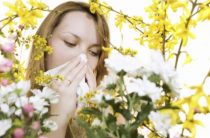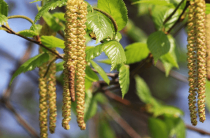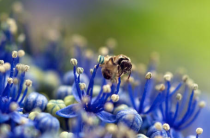We live in the 21st century, a century of rapid development of industry and technology. All this causes irreparable harm to nature, which then takes its toll on us in the form of various diseases and a low level of the immune system. As a result of this level, various types of allergies are manifested, in particular pollen allergy . This disease is provoked by various flowering plants, the process of pollination of which occurs with the help of wind. As a result, the body reacts to an irritating allergen.
Causes of Pollen Allergy
Pollinosis or, as it is also called, hay fever begins to manifest itself already from the end of March, when the first trees begin to bloom. The disease is seasonal. If it is not properly treated, pollinosis can turn into a chronic year-round form of bronchial asthma. To protect yourself, you need to know when and which plants are provocateurs.
Allergy manifests itself in the form of a rash on the body, nasal congestion and watery eyes. Often you can meet a patient with fever and headache. There may be sudden attacks of suffocation and shortness of breath. Ignoring such symptoms will lead the patient to anaphylactic shock. The first thing I would like to mention are the trees. They start blooming early. The most common allergens include birch, alder, hazel, poplar and apple. When you find your allergen, you should also think about cross-reactions that will definitely occur.
Among the reasons, there are many cereal plants. These include the following:
|
|
Very often, allergies are caused by the flowering of weeds such as ragweed, quinoa or wormwood. The pollen of these plants is the most allergenic.
This is due to the fact that a large concentration of various harmful substances is formed in the air due to emissions from enterprises that harm the immune system. And the pollen polluted by all these emissions is many times more dangerous than in its pure form. It has also been found that those flowers that are pollinated by bees rarely cause hay fever. And roses are not a source of allergen at all. Therefore, having received a bouquet of roses as a gift, do not rush to throw it away.
To protect yourself from the disease, it will be useful to know the flowering periods of plants:
| April May | Maple, birch, alder, oak, poplar, walnut, hazel, willow, elm. |
| June July | Oats, barley, wheat, wheatgrass, rye, timothy. |
| July-September | Ambrosia, plantain, wormwood, sorrel, quinoa, nettle. |
Genetic predisposition plays a huge role. Children whose mothers suffered from the disease during their gestation are at particular risk. Therefore, in the first months or even years of the child, it is necessary to carefully monitor all the reactions of his body in order to begin treatment of allergies at its initial stage.
Treatment of allergies with antihistamines
To begin treatment for pollen allergy, you need to figure out which drugs you will have to deal with. Popular borscht with the disease are antihistamines. They block the production of histamine, which gives a reaction to the allergen. These drugs can relieve itching and burning of the skin, clear the upper respiratory tract, reduce asthma attacks and cough. With allergic manifestations, such drugs act on histamine H-1. The evolution of antihistamines spans three generations. Each subsequent generation has fewer adverse reactions and a longer period of action.
First generation antihistamines
This generation is also called "classic". Subsequent ones have already repelled him. They are used at the initial manifestations of allergies. They quickly relieve the symptoms of hay fever, but have a short effect. Another significant disadvantage is their sedative effect. Therefore, the drug is contraindicated for use by patients whose work requires a high concentration of attention. They often cause dry mouth and nausea. First-generation drugs are best not taken by people suffering from diseases of the cardiovascular system. The most popular among them:
| Tavegil | Treatment of pollen allergy with this drug is carried out by blocking histamines. Removes any manifestations of hay fever. Contraindicated in bronchial asthma. Children are allowed from the age of six. Adverse reactions often include sedation, headache, and nausea. |
| Suprastin | The most versatile remedy among first-generation drugs. The effect comes quickly enough and lasts for a day. Relieves symptoms such as rhinitis, conjunctivitis, urticaria, dry skin. Approved for use by children. At the time of bearing the baby, women are allowed from the second trimester. |
| Diphenhydramine | Well eliminates inflammatory processes in the body. Removes puffiness of mucous membranes and skin. It has an extensive list of adverse reactions: drowsiness, nausea, vomiting, arrhythmia, dizziness, weakness. It is strictly contraindicated in pregnant women and children under 6 years of age. |
| Diazolin | Effective in diseases such as pollen allergy, food allergy. The result will be noticeable within 20 minutes after taking the drug. Great for removing skin rashes. Under the supervision of a physician, it is allowed to apply to women during pregnancy. |
| promethazine | The drug disrupts the work of histamines, but does not block them. Often used for prevention. It is necessary to start taking with the beginning of the season. It is not allowed to apply to people with diseases of the liver and kidneys, with various forms of intoxication, it can provoke fever, sore throat, drowsiness, stomach cramps, vomiting. |
| Chloropyramine | A fairly effective anti-allergic and antipruritic agent. It is prescribed for acute forms of hay fever, relieves conjunctivitis. Prohibited for use in peptic ulcers and bronchial asthma. May cause dizziness, leg and arm cramps, constipation, vomiting and arrhythmias. During the period of bearing a child, it is forbidden to use the drug. |
| Meclizine | It is prescribed for skin manifestations of allergies. It is strictly forbidden for children under 12 years old, as it can cause overexcitation of the nervous system. Many doctors prescribe the drug to pregnant women, but only under their strict supervision. May cause drowsiness, nausea, leg cramps and low blood pressure. |
Second generation drugs
This group of antiallergic drugs very rarely has a sedative effect. The result from the reception comes immediately and lasts more than a day. They have no temporal attachment. Not addictive. But they can affect the cardiovascular system. Also, taking such drugs is often accompanied by dry mouth and nausea. Among the most effective in the treatment of pollen allergy are the following:
| Claritin | It fights well with allergic rhinitis, severe itching, bouts of sneezing. Relieves signs of hives. Available in tablets and syrups for children. May cause nervous system excitability or drowsiness. |
| Fenistil | Removes any manifestations of hay fever. It has a variety of forms of release: drops, gel, cream, tablets. When using tablets, the effect occurs instantly. There are no contraindications, except for hypersensitivity. Rarely, headache and nausea can be found among the adverse reactions. |
| Trexil | It is the very first drug of the second generation. Effective in allergic rhinitis. It can provoke dryness of the membranes of the nasopharynx, often causes coughing fits. The only contraindication is individual intolerance to the individual components of the drug. |
| Loratadine | Removes swelling of the skin and mucous membranes. Releases the nasal cavity from sputum, freeing the breath. The result will be noticeable in half an hour and will last up to two days. Fairly well tolerated, but may cause drowsiness and fatigue. Children are allowed from the age of three. |
| Semprex | The drug is prescribed for the treatment of pollen allergy. Its maximum effectiveness occurs within an hour after administration. It has practically no adverse reactions, but is contraindicated for use by pregnant and lactating women. Children are allowed from 12 years of age. |
Third generation antihistamines
Treatment of pollen allergy with drugs of this group is most effective. Such treatment is prescribed for both pregnant women and children from the age of two months. The drugs do not cause drowsiness and have no adverse reactions. They do not have any effect on the nervous system and the work of the heart. The only drawback is their high price compared to previous generations of drugs. Popular among them include:
- Zyrtec - eliminates such allergic manifestations as urticaria, Quincke's edema, rhinitis. In rare cases, a headache may occur.
- Telfast - the drug can be used both for the prevention of hay fever, and for the treatment of its acute forms. Adverse reactions may include fatigue, diarrhea, or dizziness.
Allergy nasal treatment
If all you have is a runny nose and nasal congestion among all the allergy symptoms, then the best option would be to use nasal remedies. Preparations of this group effectively eliminate nasal congestion, free breathing, and secrete sputum. But they only relieve manifestations, and do not treat allergies. Nasal funds are divided into the following subgroups:
- Vasoconstrictor;
- Hormonal;
- Means for washing the nose;
- Immunomodulatory;
- Homeopathic.
The vasoconstrictors include the following:
| Nafazoline | Naphthyzin | Nazik | Xylometazoline |
| Phenylephrine | Vibrocil | Oxymetazoline | Adrianol |
| Xymelin | tramazolin | Otrivin | Septa Nazal |
By narrowing the vessels of the nasal cavity, these drugs help to relieve swelling of the nose, which allows you to breathe freely. The main advantage of such drops is their rapid action (from the first minutes). The effect persists for several hours. Removal of puffiness provokes the release of sputum from the sinuses. The main disadvantage is the rapid addiction. Therefore, it is forbidden to use vasoconstrictor drugs for more than five days. Addiction manifests itself in the form of drug-induced rhinitis. A person will no longer be able to breathe freely, and will have to drip his nose every two hours. Also, you can not use pregnant women, because these drugs can cause uterine cramps.
As for hormonal drugs, it is worth remembering that they are available only in the form of a spray. This is due to the fact that when using them, it is important to observe the dosage, and with a drop form it is impossible to control the process. Hormonal sprays are not addictive and do not cause atrophic changes in the mucosa. Only a doctor can prescribe such drugs, because they can provoke a violation of the hormonal background of the body.
Allergic rhinitis is often provoked by disorders of the endocrine system. Therefore, only hormonal drops are used for treatment. It is not recommended to use them for children and adults for more than five days. These drugs include:
- Nasobek;
- Aldecin;
- Baconase;
- Nasonex.
The safest for any age and condition of a person are nasal rinses. Such preparations are made on the basis of sea salt and water. They contribute to the natural restoration of the nasal mucosa, effectively free it from secretions. Quickly removes puffiness, and creates a barrier to the penetration of allergens again. These include:
| Humer | Otrivin Sea | Aqualor | Marimer |
| Aqua Maris | Dolphin | Physiomer | Quicks |
Immunomodulating drops are prescribed for stimulation and better functioning of local immunity. Such drugs prevent the re-penetration of allergy pathogens. Many of them are allowed to treat babies from the first days of their lives. The most popular among them are Deritan and IRS-19.
Creams and ointments from the manifestations of hay fever
For the treatment of pollen allergy in its skin manifestations, topical preparations such as creams and ointments are prescribed. With not pronounced manifestations, ointments are used - they have a fairly high permeability through the skin. If the skin is severely damaged, has papules and ulcers, it would be better to use creams, and for the child's body, poorly permeable preparations are provided - emulsions. All these funds can be divided into hormonal, non-hormonal and combined.
Hormones include:
| Elocom | Eliminates itching and burning. It has a high degree of permeability. Contraindicated in viral and infectious skin lesions. Adverse reactions have not previously been observed. |
| Advantan | Refers to the drugs of the latest generation. It is used in the development of various dermatitis. |
| Flucinar | It is used for a course of no more than seven days. Side effects include acne or hives. |
| Hydrocortisone ointment | Relieves inflammation and itching. It is used for puffiness and swelling of the eyelids. When using it, burning of the lower eyelids may occur. |
The disadvantage of hormonal ointments is their penetration through the skin into the blood, which causes changes in the hormonal background and dysfunction of the body systems. Very often observed in patients with dryness of the integument and their atrophy. It is not recommended to apply them on the surface of the face.
Non-hormonal creams and ointments have a minimum number of side effects and contraindications. Can be taken for a long time. It is worth noting among them the following:
- Panthenol;
- Elidel;
- Protopic;
- Thymogen;
- Lanolin.
Separately, I would like to dwell on such a tool as Fenistil gel. First of all, the gel has a cooling effect, which allows you to relieve itching and burning from the first minutes. The drug is applied in a thin layer. Due to its non-greasy base, it does not leave greasy stains on the body and clothes. Allowed to use by children and pregnant women.
Treatment of pollen allergy in children
When treating allergies in children, the first step is to go to the doctor. An allergist can help you identify the allergen by doing some tests. Since some drugs are contraindicated for children of different ages, only the doctor will select the correct therapy. Parents need to reconsider the child's diet, because pollen causes cross-reactions with products:
| Birch and apple pollen |
|
| Grass pollen |
|
| Pollen of wormwood and chamomile |
|
| quinoa pollen |
|
| Ambrosia and dandelion pollen |
|
Traditional medicine in the treatment of hay fever
Many traditional medicine recipes for the treatment of allergies have been preserved. And there is no doubt that they are quite effective and easy to prepare and use. Herbal preparations help a lot. The most effective among herbs is a series. It is brewed instead of simple tea and drunk during the day up to seven times. Such decoctions should be started to drink long before the start of the flowering season. Then you won't have problems with hay fever.
The calendula worked well. A tablespoon of grass should be poured with a glass of boiling water and insisted for about two hours. You need to drink in small doses, one spoonful, three times a day. Try to keep the course for about one month. To get rid of an allergy to pollen, you need to cleanse the body of toxins. This will help infusions of pure oats or oatmeal "Hercules". To do this, take half a kilogram of porridge, pour it into a thermos and pour two liters of boiling water. Let the infusion sit overnight. Starting the next morning, drink small doses throughout the day.
It is also recommended to follow a hypoallergenic diet. It consists in removing from your diet foods such as nuts, seafood, strawberries, raspberries, cow's milk and meat. Many of them can be replaced with soy analogues. St. John's wort is often used in the treatment. The grass must be mixed with dry tansy flowers and comfrey. Boil this mixture (300 ml of water) and strain. After cooling, simply gargle with each coughing fit or when you come home from the street.
To relieve skin manifestations, you can prepare the following ointments:
- Mix rice starch and glycerin in equal proportions. The ointment is applied in a thin layer to damaged skin.
- For cooking, you can use Vaseline and aloe juice.
- Take radish seeds and grind them into powder. Add some water to make this paste stick together and apply to the skin.
To quickly relieve itching and burning, use a regular potato or cucumber. These vegetables can be cut into circles and wipe sore spots. And you can grate and use as a compress.
To get rid of allergic rhinitis, you can use mint. To do this, brew two teaspoons of it in two cups of boiling water. Put in a warm place, or better wrap, and insist an hour. Then strain and consume internally. For a more pleasant taste, you can add one tablespoon of honey. You can also take a decoction of pine buds inside. To do this, pour a spoonful of kidneys into a cold cart. Bring to a boil over low heat. After boiling for five minutes, the broth should be infused for two hours. It should be taken up to five times a day, with the addition of honey.
For washing the nose, it is often recommended to use wood lice. Pour a few tablespoons of it with boiling water and leave for an hour. Wash twice a day. For such purposes, simple salt is also used. You need to dilute it in a glass of water and clean your nose with each congestion. If you do not suffer from honey intolerance, then honey drops can be sentenced. And honeycombs are advised to chew all year round, regardless of the presence and manifestation of allergies.
Prevention
It is always easier to follow some rules than to run around hospitals and try to cure a serious illness:
- First of all, protect yourself from contact with a possible allergen. This is especially true for pregnant women, because during this period the immune system is quite weakened.
- Keep the room you are in clean. Daily wet cleaning should be a mandatory rule. Pay special attention to the cleanliness of books, bed linen, upholstered furniture.
- It would be desirable to get rid of carpeting, and cover the floor with laminate or linoleum.
- The use of air fresheners is strictly prohibited.
- Get rid of mold and mildew in your home.
- If necessary, open the window, curtain it with a wet towel.
- Walk down the street only in the evening in calm weather.
- The ideal option would be to leave for the flowering time in another climatic zone.
- Follow the diet while eating. Don't overeat.

